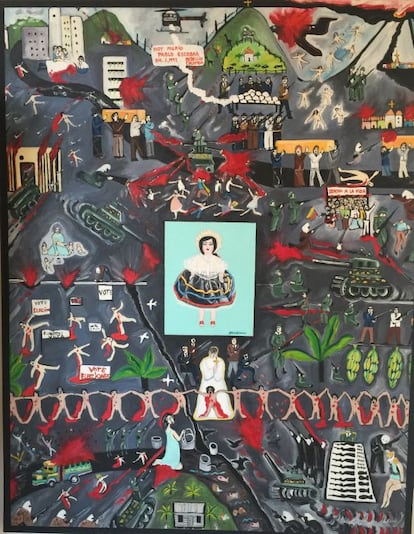“I gambled my heart and violence won it” (The maelstrom, novel by José Eustasio Rivera).
“The country is collapsing and we are partying” (popular saying).
“The danger is that you want to stay” (motto).
These three phrases, born in different times and recited by many Colombians about their country, reflect three stages of the centuries-old violence that it has experienced since the conquest, and in a spiral since April 9, 1948, when presidential candidate Jorge Eliécer Gaitán was assassinated. Now, things could be changing with the pre-peace agreement reached in Havana by the Government of Colombia and the FARC guerrillas.
A violence that has served as the sad raw material for literature, cinema, the visual arts and theatre, composed of death, terror, pain, fear and uncertainty. A genre in itself. And with very important names and essential works inside and outside Colombia. In literature, from José Eustasio Rivera, to Gabriel García Márquez, passing through contemporary authors such as Fernando Vallejo, Héctor Abad, Evelio Rosero, Darío Jaramillo, Juan Gabriel Vásquez and Laura Restrepo. In the visual arts, from Alejandro Obregón, to Doris Salcedo, passing through Débora Arango or Fernando Botero.
“Anyone who goes to Colombia immediately perceives that the threat of death is intertwined with an overwhelming fascination for life. The motherland suckles her children with both breasts: with one she gives them violence, with the other she gives them joy. As if we were living in a carnival, life and death fuel a merrymaking that is wound up by the restless vigor of the tropics,” he says. Laura Restrepo which has reflected part of that reality in novels such as Leopard in the sun. His portrait continues: “A surprising number of good writers, poets and journalists; dance and music; a fierce sense of humor; a reckless spirit; luxurious public libraries; lively and curious students; courageous mothers; a gentle detachment of teachers; selfless doctors; committed priests, a few incorruptible judges; rebellion in abundance and an almost poetic obstinacy in undertaking peace processes in the midst of war, make up in the very mouth of the volcano that safety zone where survival is protected and strengthened.”
In Colombia in recent decades, says the jurist Hernando Valencia Villa, the impact of political violence on literature and the arts has been very uneven: “While in narrative and theatre there is a very significant tradition of works related to bipartisan violence (1948-1964) and the internal armed conflict (1964-2015), in the visual arts and music there is no comparable resonance.” The expert suspects that Colombian society has become “anesthetized.” “But this moral distancing has not only been a mechanism of adaptation and survival but also a form of collaboration and complicity with barbarism.”
Literature
Literature is the one that has addressed the topic the most in all its genres, especially narrative. Hector Abad Faciolinceauthor of The oblivion that we will beabout the murder of his father, stands out the novel The Armiesby Evelio Rosero, and The sound of things fallingby Juan Gabriel Vásquez: “The first deals with the anomie of violence in the countryside; the second, with urban and rural political violence, contaminated by drug trafficking. Both the visual arts and literature manage to make a comfortable spectator or reader feel uneasy and put themselves in the role of the victims. The arts educate in empathy and in the ability to get out of ourselves. And in the evocation of one’s own pain when seeing or reading about the pain of others.”
At one point, novels about violence were a whole genre and a thick catalogue, he explains. Dario Jaramillopoet and narrator, and victim of violence. He recalls that this topic has provided “excellent materials, such as several novels and reports by García Márquez, to start from the beginning. And, furthermore, Manuel Pachoby Eduardo Caballero Calderon, Condors don’t bury every dayby Gustavo Álvarez Gardeazábal and, more recently, It was always now or never, by Rafael Baena over the last 30 years.”
One of the youngest writers is Juan Gabriel Vasquez.says that “the Colombian novel has always been obsessed with our worst demons. “I played my heart at random and violence won it,” says the narrator of The Maelstromwhich is a book written in times of peace. Two decades later, Colombia was sinking into the so-called Violencia: a partisan war that left us three hundred thousand dead, an armed conflict that continues to this day and enough novels to fill a library. The vast majority were forgettable works, born of indignation and the desire to denounce, and valuable as documents but lacking any literary interest. One of the harshest critics of these novels, the young García Márquez, accused them of being a mere inventory of the dead, and then set about the task of recounting violence in another way: that is where the novels came from. The colonel has no one to write to him and The bad hour. Since then, Colombian literature has understood—from Fernando Vallejo to Laura Restrepo, from Evelio Rosero to Héctor Abad—that the entrance to violence must be lateral and ambiguous. In other words, one must not look the Gorgon in the eye, because one runs the risk of being turned to stone.”
Art as a refuge
Hector Abad Faciolince, author of The oblivion that we will be,On the subject of her father’s murder, she says that “following the model of Goya or Picasso, there have also been artists in Colombia who have painted violence with rage and horror.” She thinks of Débora Arango, “who was nourished by German expressionism and Mexican muralism. Alejandro Obregón also painted her, and more recently Ethel Gilmour and Germán Londoño.”
The most emblematic painting of Colombian art of the 20th century, says Darío Jaramillo, is the oil painting Violence, winner of the 1962 artists’ salon by Alejandro Obregón. The painting remained in the collection of Hernando Santos for a long time, but today it can be seen on a wall of the museum of the Bank of the Republic in Bogotá.” Other artists include Luis Caballero, Fernando Botero and Doris Salcedo.
For Salcedo, who has denounced this violence and official passivity, his work “is a document of the recent history of my country told by the victims, by the defeated,” he said in an interview with EL PAÍS in 2010. A general overview is provided by critic Carlos Jiménez: “From the sharp watercolors of Débora Arango to the funereal installations of Doris Salcedo, Colombian artists have attempted with their works to offer the possibility of assuming in terms of liberating catharsis the cruelty of a history laden with death and destruction. The best among them have achieved this and it is to them that we owe gratitude for having made art a sure refuge from barbarism.”
Theater
“The theater has always had this issue very present. Because it is something more urgent and quick, the works have arrived quickly. Companies like La Candelaria, in Bogotá, with Santiago García, or TEC, in Cali, with Enrique Buenaventura, are an example of this expression as a form of art and protest,” says Carlos José Reyes, playwright, film and television scriptwriter and author of Theater and violence in 200 years of Colombian history, of which he has already published two of three volumes.
One of the historical successes of La Candelaria is Guadalupe 60swhich tells the story of the life and murder of a guerrilla by the police. And from the TEC, The papers of hell On the various topics of violence, recalls Reyes, who with his playbook has delved into the history of Colombia.
Medellin has produced authors such as Gilberto Martinez, one of the creators of the modern theatrical movement. Among contemporary playwrights, Reyes cites Jaime Aníbal Niño, Henry Díaz, José Domingo Garzón, with works such as The salty one either Boy, don’t go outon contract killing. The expert does not forget Victor Viviescas, “who has made very complex theatre. For example, The corner, shows the gangs of small hitmen in Medellin.” Reyes says that the sixties were a turning point, then came the leftist theatre. From the 90s the work stands out The brawlon the murder of members of the Patriotic Union (UP) party, the political arm of the guerrillas.
Cinema
Like theatre, cinema in its beginnings was more chronicle-like, more descriptive, but went beyond testimony and denunciation. One of the first notable films, according to Carlos José Reyes, is Canaguaro, Directed by Chilean Dunav Kuzmanich. In the nineties it was filmed Condors don’t bury every day, by Francisco Norden, which tells the story of a very violent murderer, who was called the Condor, while the other murderers were called birds.
Víctor Gaviria opens a new era with films about drug trafficking and narcoterrorism. Among them are: Rodrigo D. In the future. Films that narrate the decomposition of the northeastern neighborhoods of Medellin where the drug lord Pablo Escobar had a lot of influence. In recent years there have been other films with a certain sense of humor such as Stadium coupby Sergio Cabrera. In addition to such important literary adaptations as The Virgin of the Hitmenby Fernando Vallejo, and Rosary scissors, by Jorge Franco.
In recent years, television has dealt a lot with this subject but focused on the world of drug trafficking. One of the Colombian and international successes was the adaptation of the novel Without tits there is no paradise, by Gustavo Bolívar. As well as other series based on or inspired by books about Pablo Escobar and the Medellín and Cali cartels.
Music
Unlike Mexican narcocorridos, Colombia has not produced a very clear or popular music that speaks about violence. However, the theater has done so with works expressly created for them. In a more residual way, there are coplas, or llanera music that sings tragedies accompanied by the harp.
It is a violence that comes from very, very far back, recalls Carlos José Reyes… Then it swirls in the 19th century after independence from Spain in 1810, with its 70 civil wars that culminated in the so-called Thousand Days War. In the 20th century, the assassination of Gaitán, on April 9, 1948, was the fuse that set the country alight. Violence would be born like a jellyfish… guerrilla, paramilitaries, drug trafficking, narcoterrorism, contract killing, encouraged, at times, by the state’s own violence over the years, especially with the so-called “false positives” during the government of Álvaro Uribe, in the first decade of this century. Years of orphanhood of peace that has served as raw material for creators and a backbone on which the history of Colombians is built.
All the culture that goes with you awaits you here.
Babelia
The latest literary releases analysed by the best critics in our weekly newsletter
‘This article may contain information published by third parties, some details of this article were extracted from the following source: elpais.com’









Add Comment